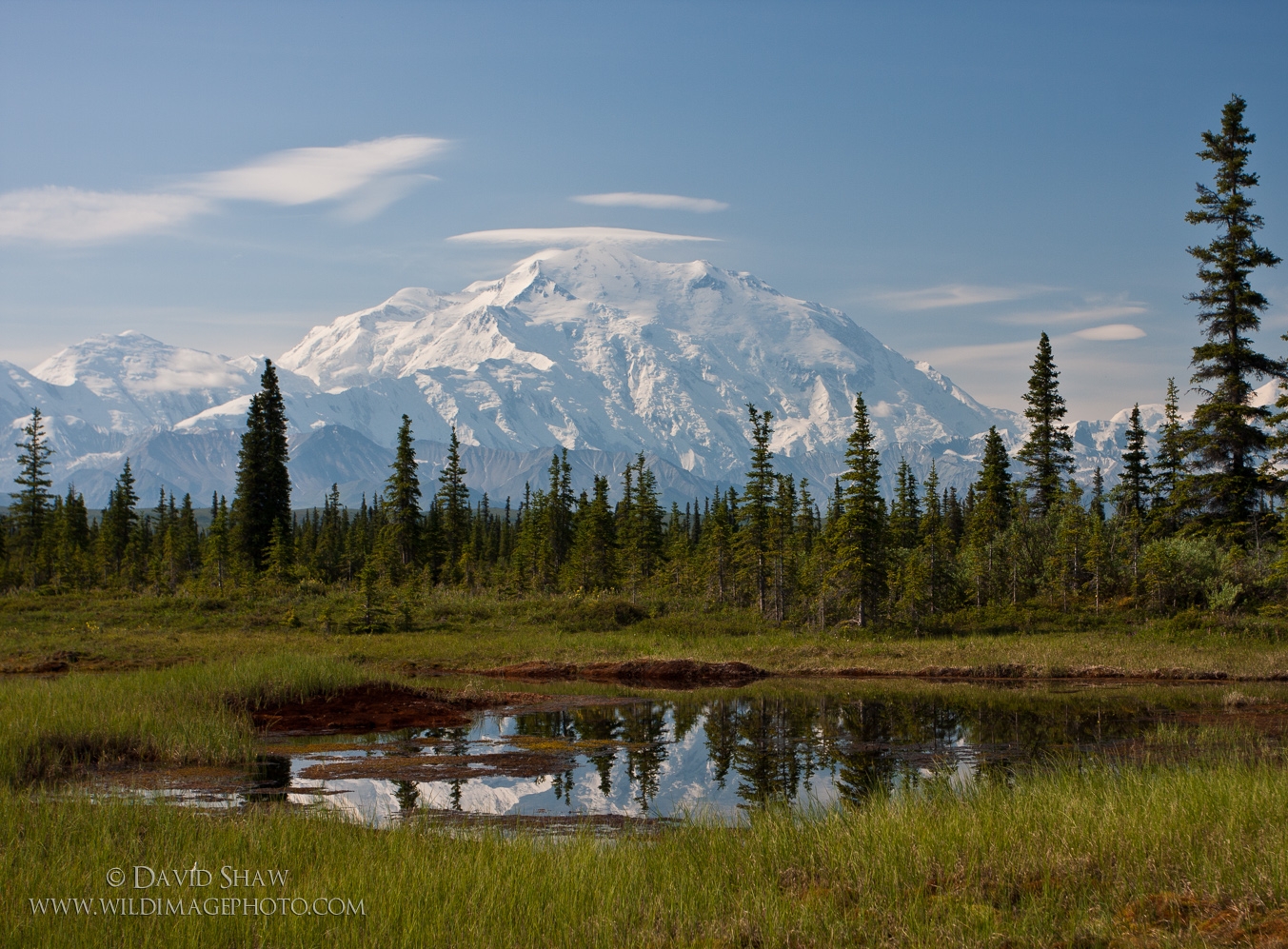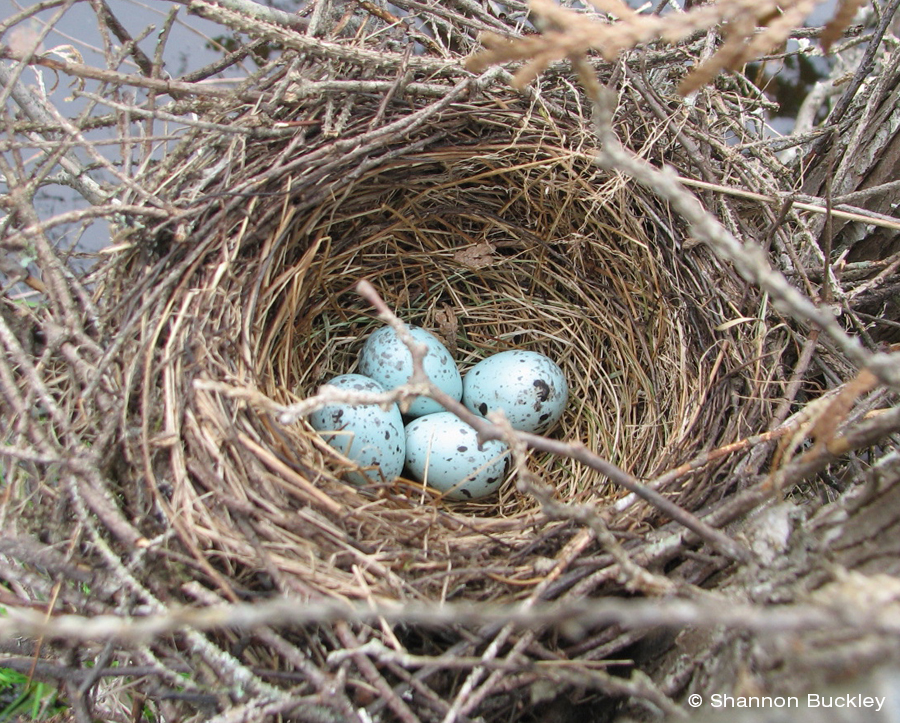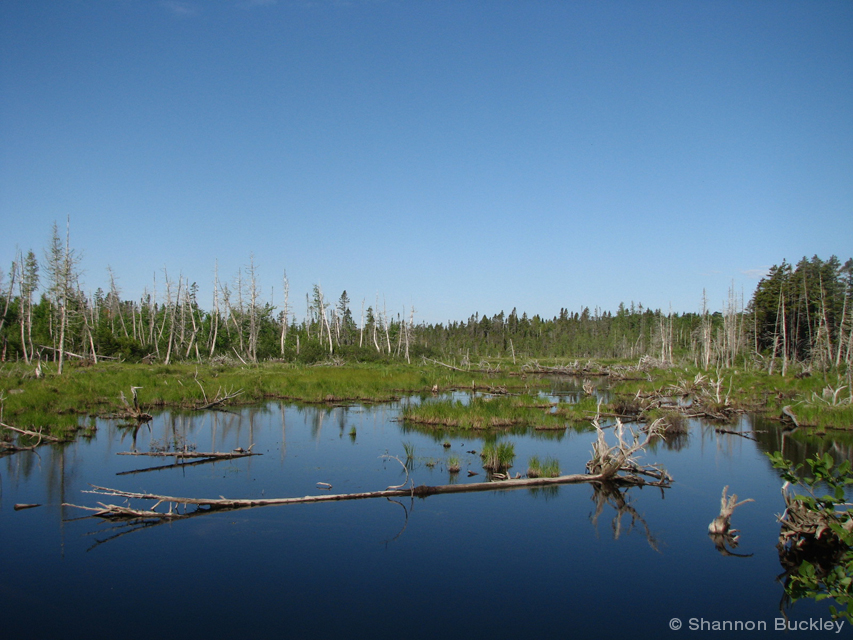Breeding
 Rusty Blackbirds breed in the vast coniferous forests of northern North America, preferring wetland mosaics with patches of short conifers (Matsuoka et al. 2010, Powell et al. 2010, Buckley 2013). They are one of the earliest migrants to arrive on breeding grounds in the spring, and start building nests as early as mid-April. Nesting pairs are often spread out across the landscape, but sometimes they nest in loose colonies, with multiple nests within a few hundred meters.
Rusty Blackbirds breed in the vast coniferous forests of northern North America, preferring wetland mosaics with patches of short conifers (Matsuoka et al. 2010, Powell et al. 2010, Buckley 2013). They are one of the earliest migrants to arrive on breeding grounds in the spring, and start building nests as early as mid-April. Nesting pairs are often spread out across the landscape, but sometimes they nest in loose colonies, with multiple nests within a few hundred meters.
 The female alone builds the nest, a bulky cup composed of sticks and coarse grasses, usually placed 1-3 m high in a small conifer. Often, nests are in or near wetlands, as aquatic insects make up the bulk of the species’ diet during the breeding season (Avery 1995). Beginning in late April and early May, females lay 3-5 pale blue eggs with brown markings. Only the female incubates the eggs, but the male periodically feeds her at the nest or at a nearby perch. Eggs hatch approximately two weeks later, and both parents help to feed nestlings, sometimes with the assistance of a second male. The nestlings develop rapidly and leave the nest 10-12 days after hatching.
The female alone builds the nest, a bulky cup composed of sticks and coarse grasses, usually placed 1-3 m high in a small conifer. Often, nests are in or near wetlands, as aquatic insects make up the bulk of the species’ diet during the breeding season (Avery 1995). Beginning in late April and early May, females lay 3-5 pale blue eggs with brown markings. Only the female incubates the eggs, but the male periodically feeds her at the nest or at a nearby perch. Eggs hatch approximately two weeks later, and both parents help to feed nestlings, sometimes with the assistance of a second male. The nestlings develop rapidly and leave the nest 10-12 days after hatching.
 Currently, Rusty Blackbirds face several challenges on their breeding grounds. Because they feed in wetlands, which readily convert mercury to the more harmful and bioavailable methylmercury, Rusty Blackbirds often have relatively high levels of this toxic metal in their bodies (Edmonds et al. 2010). Recent research shows that the Rusty Blackbird breeding range is shrinking in size and retracting to the north, suggesting climate change may also be affecting the species (Powell 2008, McClure et al. 2012). Warmer weather patterns are causing the wetlands that Rusty Blackbirds rely on for food to dry up, and may also be shifting the timing of insect development. Another side-effect of climate change is the expansion of other blackbird species like Redwing Blackbirds and Common Grackles into northern forests, where they are aggressive competitors with Rusty Blackbirds. Finally, predators are a major threat for young Rusty Blackbirds both in and out of the nest.
Currently, Rusty Blackbirds face several challenges on their breeding grounds. Because they feed in wetlands, which readily convert mercury to the more harmful and bioavailable methylmercury, Rusty Blackbirds often have relatively high levels of this toxic metal in their bodies (Edmonds et al. 2010). Recent research shows that the Rusty Blackbird breeding range is shrinking in size and retracting to the north, suggesting climate change may also be affecting the species (Powell 2008, McClure et al. 2012). Warmer weather patterns are causing the wetlands that Rusty Blackbirds rely on for food to dry up, and may also be shifting the timing of insect development. Another side-effect of climate change is the expansion of other blackbird species like Redwing Blackbirds and Common Grackles into northern forests, where they are aggressive competitors with Rusty Blackbirds. Finally, predators are a major threat for young Rusty Blackbirds both in and out of the nest.
In spite of such perils, however, studies of nesting Rusty Blackbirds show relatively high rates of survival on the breeding grounds. Thus, hazards during migration or on the wintering grounds may present the greatest conservation challenges for this vulnerable species.
REFERENCES
Avery, M. L. 1995. Rusty Blackbird (Euphagus carolinus). In: The birds of North America (F. B. Gill and A. Poole, eds.), no. 200. Academy of Natural Sciences, Philadelphia, PA.
Buckley, S. 2013. Rusty Blackbirds in northeastern U.S. industrial forests: A multi-scale study of nest habitat selection and nest survival. M. Sc. Thesis, SUNY College of Environmental Science and Forestry, Syracuse, NY.
Edmonds, S. T., D. C. Evers, D. A. Cristol, C. Mettke-Hofmann, L. L. Powell, A. J. McGann, J. A. Armiger, O. P. Lane, D. F. Tessler, P. Newell, K. Heyden, and N. J. O’Driscoll. 2010. Geographic and seasonal variation in mercury exposure of the declining Rusty Blackbird. Condor 112:789-799.
Matsuoka, S. M., D. Shaw, P. Sinclair, J. Johnson, R. Corcoran, N. Dau, P. Meyers, and N. Rojek. 2010. Nesting ecology of the Rusty Blackbird in Alaska and Canada. Condor 112:810-824.
McClure, C. J. W., B. W. Rolek, K. McDonald, and G. E. Hill. 2012. Climate change and the decline of a once common bird. Ecology and Evolution 2:370-378.
Powell, L. L. 2008. Habitat occupancy, status, and reproductive ecology of Rusty Blackbirds in New England. M. Sc. Thesis, University of Maine, Orono, ME.
Powell, L. L., T. P. Hodgman, W. E. Glanz, J. D. Osenton, and C. M. Fisher. 2010. Nest-site selection and nest survival of the Rusty Blackbird: Does timber management adjacent to wetlands create ecological traps? Condor 112:800-809.
